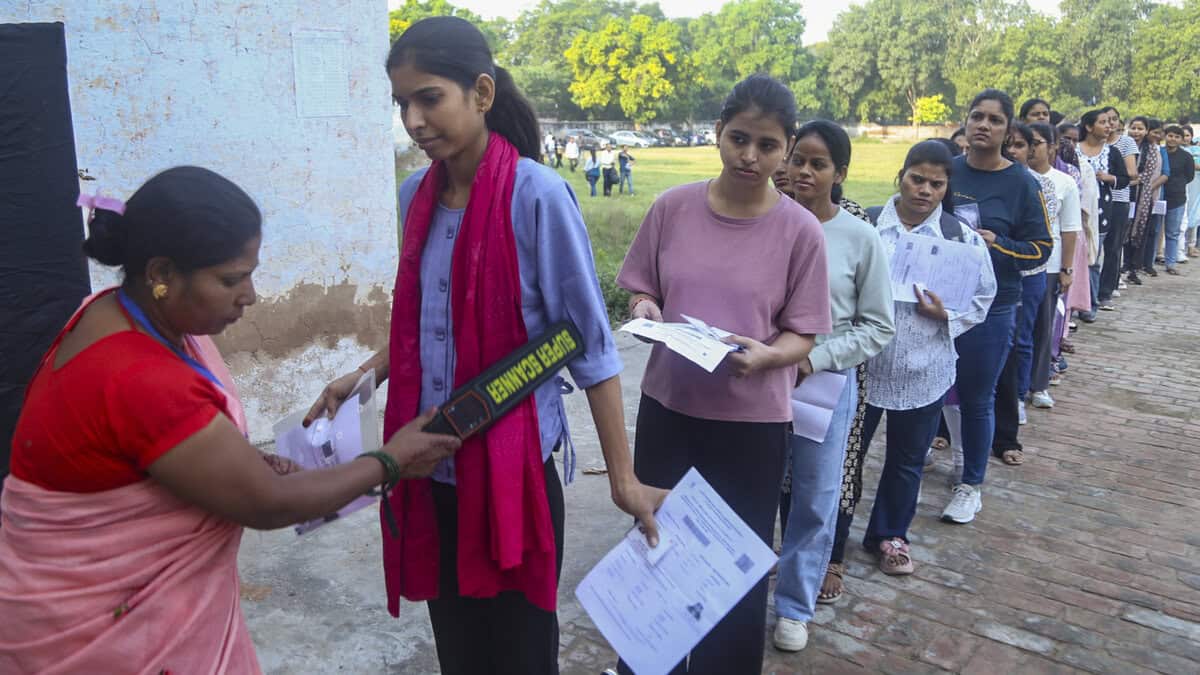Amna Nawaz:
The markets may have finished this day on a mixed note, but if you have been watching in recent months, you will have noticed the markets have continued to be strong, despite continuing concerns around the shutdown, tariffs, and inflation.
In fact, the broadest index, the S&P 500, and the tech-heavy Nasdaq have set records more than 30 times this year. And there’s other data that suggests the economy is still chugging along at a steady clip. But that is only part of what’s happening.
As our economics correspondent Paul Solman reports, for the vast majority of Americans, this economy is landing very differently right now.
Mark Zuckerberg (CEO, Meta):
This is Meta Ray-Ban Display.
Paul Solman:
You don’t have to look far to get a clear view of those at the tippy top of the economy.
Mark Zuckerberg:
The first A.I. glasses with a high-resolution display.
Paul Solman:
Mark Zuckerberg’s Meta paying $250 million to recruit an artificial intelligence researcher, a proposed $1 trillion compensation package for Tesla CEO Elon Musk, former Google head Eric Schmidt’s purchase of a 123-room $110 million L.A. mansion to host events.
But well below the hyper-rich, millions of other Americans are also prospering. As evidence, 56 percent of luxury consumers, according to Saks Global, plan to spend the same or more this season compared to last, up substantially from just last spring.
Misty Belles, Vice President of Global Public Relations, Virtuoso: Luxury travel continues to hold very strong.
Paul Solman:
Misty Belles of luxury travel network Virtuoso sees the same.
Misty Belles:
When we look at our fall bookings for this year, we are up 38 percent year over year.
Paul Mac Garvey, Retiree:
If I wanted to go buy a Rolls-Royce, I could do it right now and pay cash.
Paul Solman:
Paul Mac Garvey and his wife aren’t big travelers, but, comfortably retired, they are insulated.
Paul Mac Garvey:
I do a net worth survey on the Fidelity Web site every week, and it just does nothing but go up. All right, my net worth keeps going up.
Paul Solman:
John (ph), a retired engineer, is also pretty comfortable.
John, Retiree:
I own my own house. I own a couple of cars. I have everything that I really want.
Paul Solman:
Problem is, even when you include these upper-middle-income Americans among the prosperous, that still leaves a full 80 percent who are feeling squeezed, like geologist Timothy Runkle.
Timothy Runkle, Geologist:
It doesn’t really matter what I’m doing in my career or what other jobs that I’m pursuing. It just doesn’t keep up with what the necessities of life are right now.
Paul Solman:
Donna (ph) is in sales.
Donna, Employed in Sales: I haven’t taken a vacation in over almost 2.5 years.
Paul Solman:
Joseph Williamson, a city planner in Collinsville, Illinois, proud home of the world’s largest ketchup bottle.
Joseph Williamson, City Planner:
Honestly, right now, as we speak, $200 to my name, maybe.
Paul Solman:
Fiori Berhane, assistant professor.
Fiori Berhane, Assistant Professor:
I have student loans and medical debt.
Paul Solman:
Emily Zerrenner is a librarian.
Emily Zerrenner, Librarian:
I’m finding myself needing to use the by-now, pay-later things for bigger purchases, such as like car repairs.
Paul Solman:
One way to depict the increasing split between the top 20 percent and the rest of Americans, says economist Mark Zandi, the letter K.
Mark Zandi, Chief Economist, Moody’s Analytics:
The folks at the top part of the income and wealth distribution are doing fabulously well. And, of course, folks at the bottom part of the K, lower-, middle-income households, they’re struggling.
Paul Solman:
Heather Long wrote about the K-shaped economy in The Washington Post.
Heather Long, Navy Federal Credit Union:
This economy right now is being driven by spending from the top 20 percent of Americans. So that dividing line is roughly $175,000.
Families that are above that mark, they’re living la vida loca. You know, they’re out there. They’re spending on birthday parties and lavish weddings and big trips abroad and growing their spending month after month. And the rest of America, the bottom 80 percent, they’re cautious right now.
Mark Zandi:
Their incomes having kept pace with inflation. They’re encumbered with debt. They don’t have any assets.
Paul Solman:
Assets to benefit from.
Mark Zandi:
The stock market is booming. We have record valuations. All that accrues to the folks with big stock portfolios, and that’s in the top 10 percent of the distribution. They own their own home. They own bonds They own crypto. They own lots of stuff.
Paul Solman:
Of course, American wealth inequality is hardly new. Point is, it’s getting worse.
Heather Long:
You can go back to kind of the early ’90s, and the top 10 percent, the wealthiest Americans, they would account for 35 percent of overall spending. So a pretty good chunk was reliant on the top. But, today, that number is basically 50 percent. Half of spending is now dependent on just the top 10 percent.
Paul Solman:
That’s households making about $250,000 or more.
The economy is more reliant on them than ever. Official consumer spending is rising, thanks to folks like Belles’ high-end travel customers.
Misty Belles:
Suites are still selling very well at hotels. Junior suites, anything that’s in the upper category there, business class, premium economy, all of those upper categories continue to hold strong.
Paul Solman:
Washington, D.C., realtor Michael Rankin specializes in the luxury market.
Michael Rankin, Sotheby’s International Realty:
It is very strong and very robust. They have been buying and spending a lot of money.
Paul Solman:
In fact, his challenge is there aren’t enough houses for his high-end clients to buy.
Michael Rankin:
What we have now is a scarcity of supply of the super high end, and our marketplace is $7 million, $10 million, $15 million, even higher. I have active buyers and clients who are looking for something very special, very well renovated, very well presented. And there’s just a scarcity of supply.
Paul Solman:
But while the well-off are fueling the economy, so many others are pinching pennies, looking to spend less on just the basics at discount stores like Dollar General, which recently reported an increase in middle- and higher-income shoppers.
And budget grosser Aldi is America’s fastest growing retailer.
Joseph Williamson:
I’m spending sometimes upwards of $150, $200 a week on groceries.
Paul Solman:
Joe Williamson’s pay is barely keeping up with prices at the store, like so many Americans.
Emily Zerrenner:
I used to be a person who would pay off my credit card every single month. I wouldn’t keep a balance at all, but I have had to start keeping a balance, and I’m not able to pay it off every month.
Paul Solman:
This summer, Jessica Cuevas (ph) and her husband moved their family to Mexico because they could no longer afford to live in Chicago on her husband’s $67,000-a-year salary.
Jessica Cuevas, Expat:
Rent is about 1,000 U.S. dollars. In Chicago, where we’re from, it could be anywhere between $25,000 to $5,000.
Paul Solman:
And Cuevas can work too since she can now afford day care.
Jessica Cuevas:
That alone is about $150 a month, compared to $1,400.
Paul Solman:
Now the K bifurcation isn’t just among households.
Heather Long:
There’s also a K-shaped situation going on the business side. And you can look at the stock market, and it’s being hugely driven by a handful of superstar tech companies that are involved in the A.I. boom. And they’re just in a totally different league right now than everybody else.
Paul Solman:
And they, it turns out, are driving the economy.
Heather Long:
In the first half of 2025, spending on A.I. was as big of a contributor to growth in this country as consumption. There’s a lot of risk to an economy that is so heavily reliant on this A.I. boom and the rich. And there could be some pullback. If your chair has fewer and fewer legs to stand on, it’s a lot easier to knock that over.
Paul Solman:
Meanwhile, the A.I. boom means more data centers devouring more energy, driving up electricity prices for the already strapped 80 percent.
Joseph Williamson:
Everybody around me has either doubled or tripled in their power expenses, and we can’t afford it.
Paul Solman:
Not to mention rising rents as investors buy up presidential real estate.
Fiori Berhane:
My rent is going to continue rising, and my pay isn’t.
Paul Solman:
So why not buy instead?
Emily Zerrenner:
I do not feel like I could ever buy a house. That’s not even on my radar, quite honestly.
Paul Solman:
Just 25 percent of Americans these days feel they have a good chance of improving their standard of living, a record low.
Why do you suppose there hasn’t been a revolt from the bottom, the pitchforks, in one cliched version of the revolt?
Mark Zandi:
There’s clearly a lot of skewing of the income and wealth distribution, but times historically when you have seen, as you say, the pitchforks coming out, the skewing is much more pronounced. We’re not living in Paris, France, circa late 1700s, for example.
Paul Solman:
That is even the bottom arm of the K.
Mark Zandi:
Making 50, 75 K a year here in the U.S., your standard of living, just given the improvements in technologies and everything else, is probably as good as the Hearsts were back 100 years ago when they were in their castle.
Paul Solman:
A castle without air conditioning, TV, the Internet, access to modern medicine, and so much we now take for granted. On the other hand, that man’s home was a castle.
For the “PBS News Hour,” Paul Solman.

















































